Page 290 of 473
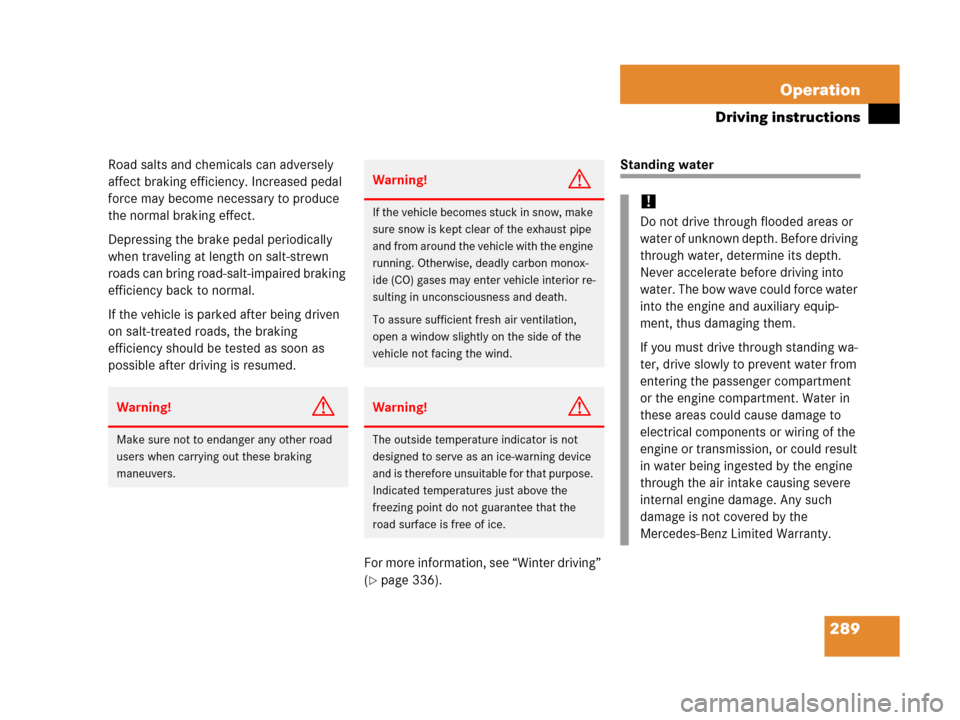
289 Operation
Driving instructions
Road salts and chemicals can adversely
affect braking efficiency. Increased pedal
force may become necessary to produce
the normal braking effect.
Depressing the brake pedal periodically
when traveling at length on salt-strewn
roads can bring road-salt-impaired braking
efficiency back to normal.
If the vehicle is parked after being driven
on salt-treated roads, the braking
efficiency should be tested as soon as
possible after driving is resumed.
For more information, see “Winter driving”
(
�page 336).
Standing water
Warning!G
Make sure not to endanger any other road
users when carrying out these braking
maneuvers.
Warning!G
If the vehicle becomes stuck in snow, make
sure snow is kept clear of the exhaust pipe
and from around the vehicle with the engine
running. Otherwise, deadly carbon monox-
ide (CO) gases may enter vehicle interior re-
sulting in unconsciousness and death.
To assure sufficient fresh air ventilation,
open a window slightly on the side of the
vehicle not facing the wind.
Warning!G
The outside temperature indicator is not
designed to serve as an ice-warning device
and is therefore unsuitable for that purpose.
Indicated temperatures just above the
freezing point do not guarantee that the
road surface is free of ice.
!
Do not drive through flooded areas or
water of unknown depth. Before driving
through water, determine its depth.
Never accelerate before driving into
water. The bow wave could force water
into the engine and auxiliary equip-
ment, thus damaging them.
If you must drive through standing wa-
ter, drive slowly to prevent water from
entering the passenger compartment
or the engine compartment. Water in
these areas could cause damage to
electrical components or wiring of the
engine or transmission, or could result
in water being ingested by the engine
through the air intake causing severe
internal engine damage. Any such
damage is not covered by the
Mercedes-Benz Limited Warranty.
Page 308 of 473
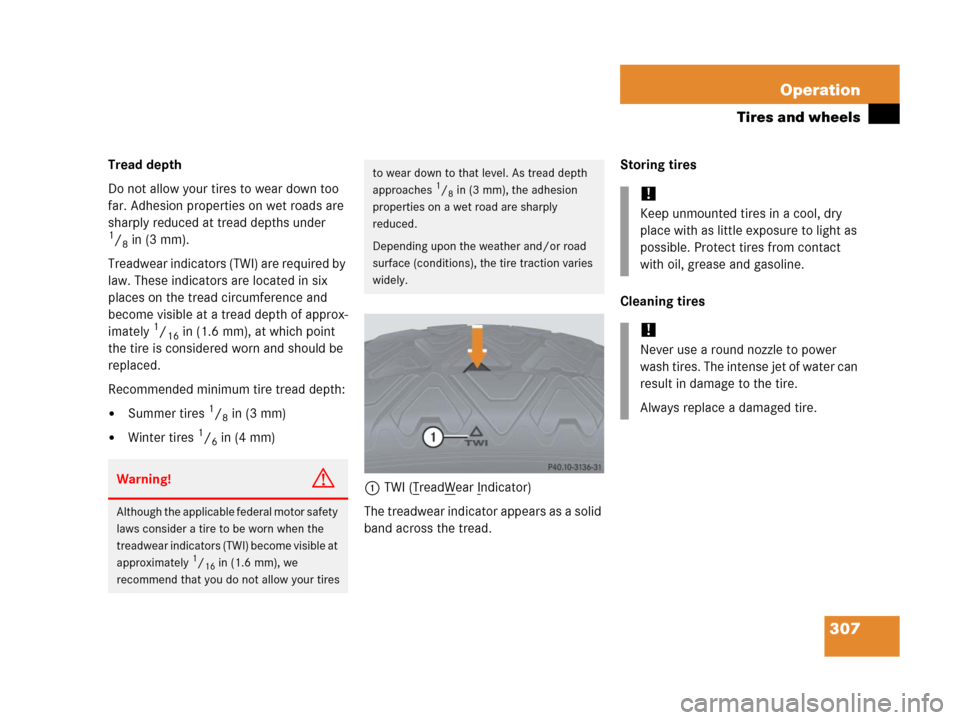
307 Operation
Tires and wheels
Tread depth
Do not allow your tires to wear down too
far. Adhesion properties on wet roads are
sharply reduced at tread depths under
1/8in (3 mm).
Treadwear indicators (TWI) are required by
law. These indicators are located in six
places on the tread circumference and
become visible at a tread depth of approx-
imately
1/16in (1.6 mm), at which point
the tire is considered worn and should be
replaced.
Recommended minimum tire tread depth:
�Summer tires 1/8in (3 mm)
�Winter tires 1/6in (4 mm)
1TWI (T
readWear Indicator)
The treadwear indicator appears as a solid
band across the tread.Storing tires
Cleaning tiresWarning!G
Although the applicable federal motor safety
laws consider a tire to be worn when the
treadwear indicators (TWI) become visible at
approximately
1/16in (1.6 mm), we
recommend that you do not allow your tires
to wear down to that level. As tread depth
approaches 1/8in (3 mm), the adhesion
properties on a wet road are sharply
reduced.
Depending upon the weather and/or road
surface (conditions), the tire traction varies
widely.!
Keep unmounted tires in a cool, dry
place with as little exposure to light as
possible. Protect tires from contact
with oil, grease and gasoline.
!
Never use a round nozzle to power
wash tires. The intense jet of water can
result in damage to the tire.
Always replace a damaged tire.
Page 348 of 473
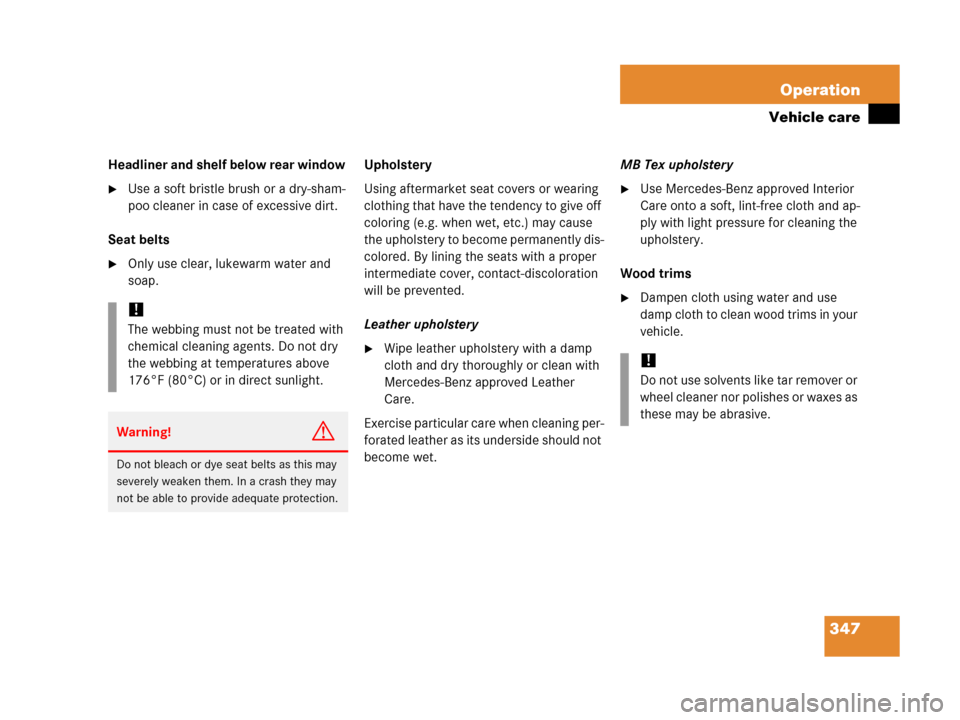
347 Operation
Vehicle care
Headliner and shelf below rear window
�Use a soft bristle brush or a dry-sham-
poo cleaner in case of excessive dirt.
Seat belts
�Only use clear, lukewarm water and
soap.Upholstery
Using aftermarket seat covers or wearing
clothing that have the tendency to give off
coloring (e.g. when wet, etc.) may cause
the upholstery to become permanently dis-
colored. By lining the seats with a proper
intermediate cover, contact-discoloration
will be prevented.
Leather upholstery
�Wipe leather upholstery with a damp
cloth and dry thoroughly or clean with
Mercedes-Benz approved Leather
Care.
Exercise particular care when cleaning per-
forated leather as its underside should not
become wet.MB Tex upholstery
�Use Mercedes-Benz approved Interior
Care onto a soft, lint-free cloth and ap-
ply with light pressure for cleaning the
upholstery.
Wood trims
�Dampen cloth using water and use
damp cloth to clean wood trims in your
vehicle.!
The webbing must not be treated with
chemical cleaning agents. Do not dry
the webbing at temperatures above
176°F (80°C) or in direct sunlight.
Warning!G
Do not bleach or dye seat belts as this may
severely weaken them. In a crash they may
not be able to provide adequate protection.
!
Do not use solvents like tar remover or
wheel cleaner nor polishes or waxes as
these may be abrasive.
Page 386 of 473
385 Practical hints
Where will I find ...?
Spare wheel bolts
1Wheel bolt for light alloy rims
2Wheel bolt for spare wheel (located in
trunk with spare wheel)!
Wheel bolts2 must be used when
mounting the spare wheel. The use of
any wheel bolts other than wheel
bolts2 for the spare wheel will physi-
cally damage the vehicle’s brakes.
Warning!G
Make sure to use the original length wheel
bolts when remounting the original wheel
after it has been repaired.
Page 397 of 473
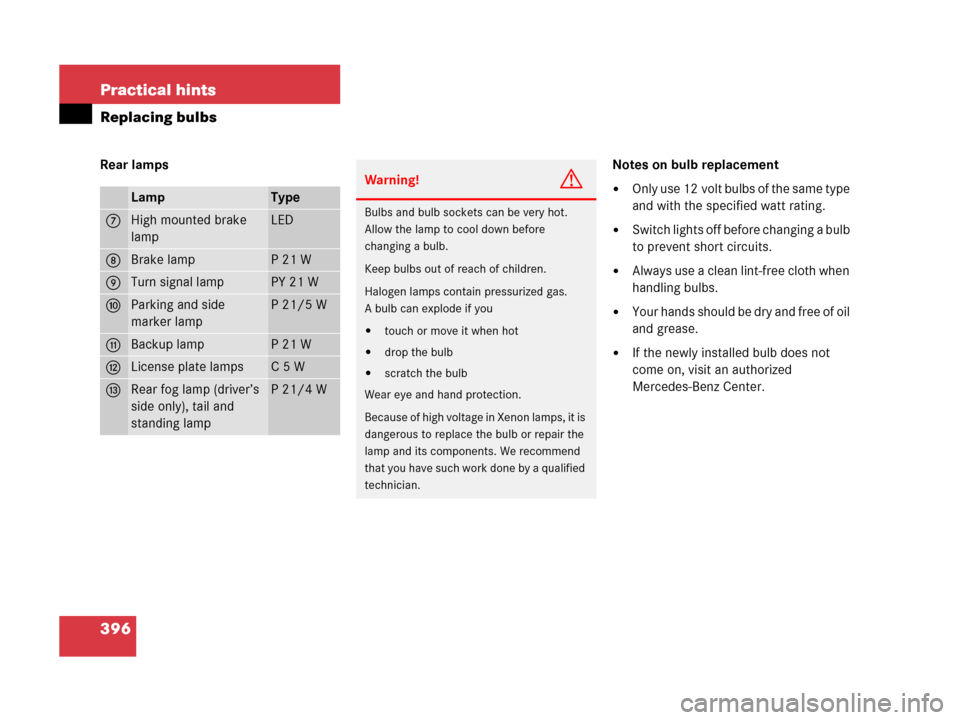
396 Practical hints
Replacing bulbs
Rear lamps Notes on bulb replacement
�Only use 12 volt bulbs of the same type
and with the specified watt rating.
�Switch lights off before changing a bulb
to prevent short circuits.
�Always use a clean lint-free cloth when
handling bulbs.
�Your hands should be dry and free of oil
and grease.
�If the newly installed bulb does not
come on, visit an authorized
Mercedes-Benz Center.
LampType
7High mounted brake
lampLED
8Brake lampP21W
9Turn signal lampPY 21 W
aParking and side
marker lampP 21/5 W
bBackup lampP21W
cLicense plate lampsC5W
dRear fog lamp (driver’s
side only), tail and
standing lampP 21/4 W
Warning!G
Bulbs and bulb sockets can be very hot.
Allow the lamp to cool down before
changing a bulb.
Keep bulbs out of reach of children.
Halogen lamps contain pressurized gas.
A bulb can explode if you
�touch or move it when hot
�drop the bulb
�scratch the bulb
Wear eye and hand protection.
Because of high voltage in Xenon lamps, it is
dangerous to replace the bulb or repair the
lamp and its components. We recommend
that you have such work done by a qualified
technician.
Page 408 of 473
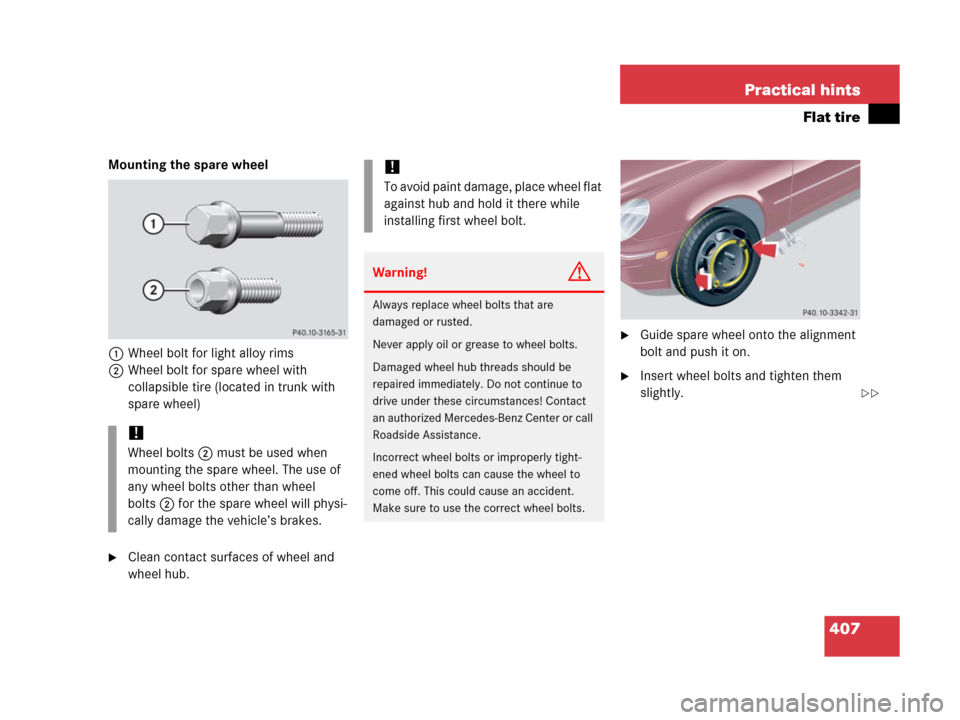
407 Practical hints
Flat tire
Mounting the spare wheel
1Wheel bolt for light alloy rims
2Wheel bolt for spare wheel with
collapsible tire (located in trunk with
spare wheel)
�Clean contact surfaces of wheel and
wheel hub.
�Guide spare wheel onto the alignment
bolt and push it on.
�Insert wheel bolts and tighten them
slightly.
!
Wheel bolts2 must be used when
mounting the spare wheel. The use of
any wheel bolts other than wheel
bolts2 for the spare wheel will physi-
cally damage the vehicle’s brakes.
!
To avoid paint damage, place wheel flat
against hub and hold it there while
installing first wheel bolt.
Warning!G
Always replace wheel bolts that are
damaged or rusted.
Never apply oil or grease to wheel bolts.
Damaged wheel hub threads should be
repaired immediately. Do not continue to
drive under these circumstances! Contact
an authorized Mercedes-Benz Center or call
Roadside Assistance.
Incorrect wheel bolts or improperly tight-
ened wheel bolts can cause the wheel to
come off. This could cause an accident.
Make sure to use the correct wheel bolts.
��
Page 409 of 473
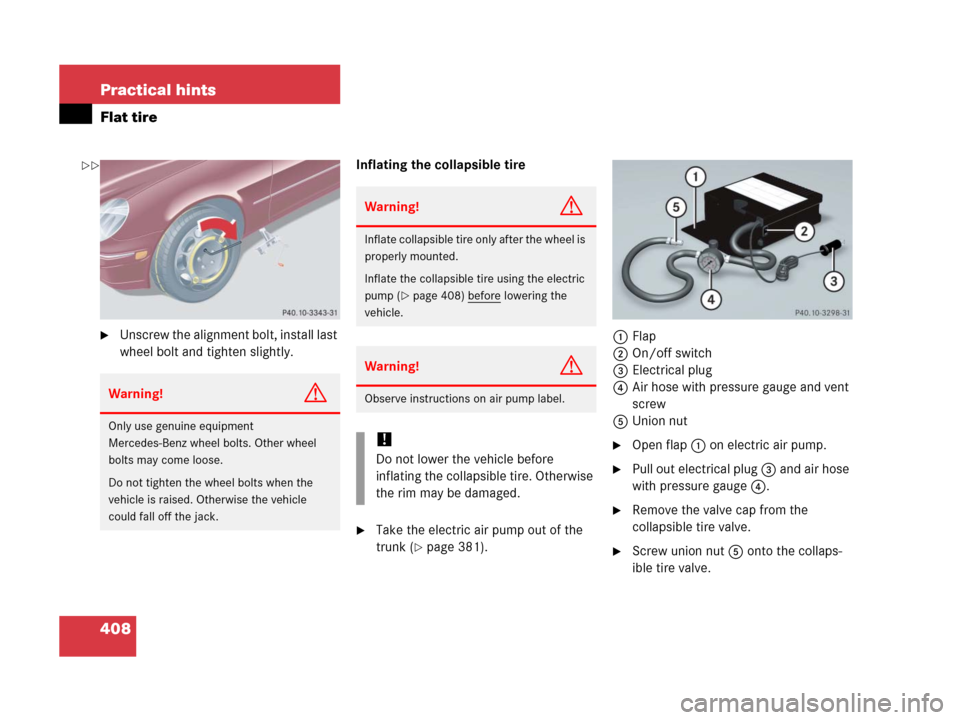
408 Practical hints
Flat tire
�Unscrew the alignment bolt, install last
wheel bolt and tighten slightly.Inflating the collapsible tire
�Take the electric air pump out of the
trunk (
�page 381).1Flap
2On/off switch
3Electrical plug
4Air hose with pressure gauge and vent
screw
5Union nut
�Open flap 1 on electric air pump.
�Pull out electrical plug 3 and air hose
with pressure gauge 4.
�Remove the valve cap from the
collapsible tire valve.
�Screw union nut5 onto the collaps-
ible tire valve.
Warning!G
Only use genuine equipment
Mercedes-Benz wheel bolts. Other wheel
bolts may come loose.
Do not tighten the wheel bolts when the
vehicle is raised. Otherwise the vehicle
could fall off the jack.
Warning!G
Inflate collapsible tire only after the wheel is
properly mounted.
Inflate the collapsible tire using the electric
pump (
�page 408) before lowering the
vehicle.
Warning!G
Observe instructions on air pump label.
!
Do not lower the vehicle before
inflating the collapsible tire. Otherwise
the rim may be damaged.
��
Page 410 of 473
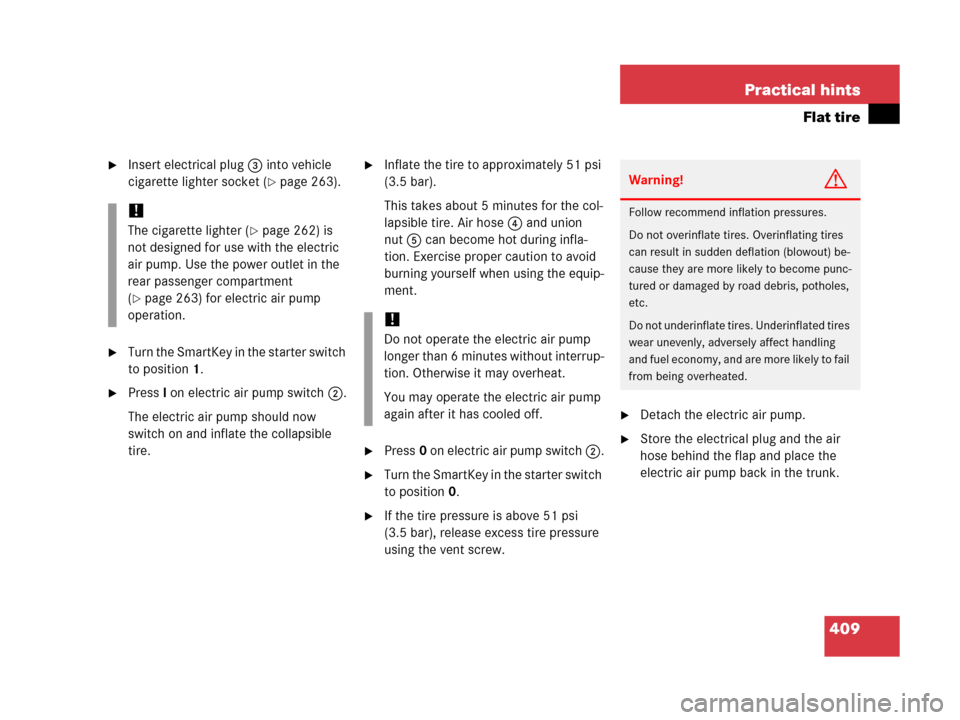
409 Practical hints
Flat tire
�Insert electrical plug 3 into vehicle
cigarette lighter socket (
�page 263).
�Turn the SmartKey in the starter switch
to position1.
�PressI on electric air pump switch 2.
The electric air pump should now
switch on and inflate the collapsible
tire.
�Inflate the tire to approximately 51 psi
(3.5 bar).
This takes about 5 minutes for the col-
lapsible tire. Air hose 4 and union
nut5 can become hot during infla-
tion. Exercise proper caution to avoid
burning yourself when using the equip-
ment.
�Press0 on electric air pump switch 2.
�Turn the SmartKey in the starter switch
to position0.
�If the tire pressure is above 51 psi
(3.5 bar), release excess tire pressure
using the vent screw.
�Detach the electric air pump.
�Store the electrical plug and the air
hose behind the flap and place the
electric air pump back in the trunk.
!
The cigarette lighter (�page 262) is
not designed for use with the electric
air pump. Use the power outlet in the
rear passenger compartment
(
�page 263) for electric air pump
operation.
!
Do not operate the electric air pump
longer than 6 minutes without interrup-
tion. Otherwise it may overheat.
You may operate the electric air pump
again after it has cooled off.
Warning!G
Follow recommend inflation pressures.
Do not overinflate tires. Overinflating tires
can result in sudden deflation (blowout) be-
cause they are more likely to become punc-
tured or damaged by road debris, potholes,
etc.
Do not underinflate tires. Underinflated tires
wear unevenly, adversely affect handling
and fuel economy, and are more likely to fail
from being overheated.